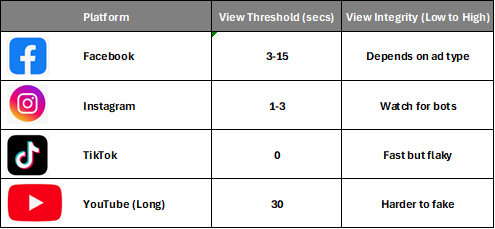What's The Value Of A Social Media View?
And Why It Matters To Musicians Growing A Fanbase
If you’re actively promoting your music across social media, you no doubt look at a variety of metrics to determine the success of every post or every ad.
One of the most common of these metrics is the “View.”
But what is a view exactly?
Is it the same on each platform? Spoiler alert … it’s not!
And what types of view are more valuable to the music artist?
Understanding the view metric is hugely important. Whether chasing reach, building a fanbase or selling merchandise to a dedicated following, you want to maximise the effectiveness of any social media activity.
In today’s edition of The Music Marketer, we’ll help you navigate the choppy waters of views and viewability.
The Definition of a Social Media View
Rather unhelpfully perhaps, each social media platform has its own rules for what counts as a view. So, when it comes to understanding the differences, it’s a bit like everyone in a band playing the same song in a different tuning! Improvised jazz perhaps. But not nice for easy analysis.
Here’s how the major players, Meta (Facebook and Instagram), TikTok and YouTube, define a view in their own ecosystems.
Facebook
Organic (Free) and Paid Views
A video view is counted after 3 seconds of watching time, even if the video auto-plays while the user scrolls past it.
ThruPlays
For ad placements, this is the main metric. It’s a user who watched at least 15 seconds or the whole video if it’s shorter.
Key Takeout
Auto-play equates to an inflated figure for views. If you’re focussed on real engagement for content or video ads, you should monitor watch time or how long people stay on your videos.
Instagram
Feed Video Views (Reels and IGTV)
Counted after 3 seconds. Like Facebook, auto-play can lead to an inflated perception of the value of any views.
Stories
A view is counted if someone merely opens your Story, even if they skip it after a split second.
Reels
Just 1 second is enough to be registered as a view. While this may be great for “token” exposure figures, it’s clearly not necessarily a sign of real interest.
TikTok
Organic and Paid Views
We know TikTok is all about fast, shorter content. As you might expect, a view is therefore counted the moment a video plays, even if it’s just a fleeting glimpse! You can rack up “views” really quickly on the platform, but did the user actually pay any attention to the content posted?
Organic Posts
It’s definitely worth looking beyond views, towards engagement stats, such as likes, comments and shares. This gives a more rounded analysis of performance.
Paid Ads
TikTok offers more in-depth breakdowns like 2-second, 6-second and 100% views for those who watched the whole thing.
YouTube
Quality Over Quantity
A view only counts when someone intentionally starts watching and stays on the video for at least 30 seconds. If it’s shorter, they need to watch the whole thing.
Organic Versus Paid
The same rules apply. For ad placements, data on how long people watched before they skipped is also available.
YouTube Shorts
These are more recent additions to the YouTube world and views count immediately at the start of playback. Stick to the classic YouTube formats as a first port of call, unless you have a very specific reason to use Shorts.
Judging Effectiveness
When reviewing statistics for views on social media activity, ensure you look beyond the basic numbers. Where available, utilise time-viewed breakdowns. The longer the viewing time, the more likely the user has actually noticed and absorbed your content.
Use engagement statistics for posts or ad placements to also understand traction beyond basic viewing metrics.
Once you have enough data, look to create specific target audience segments in the platforms based upon those with longer viewing times or who are more highly engaged. This should improve performance further over time.
Fake Plastic Views
Okay, forgive me for the tenuous Radiohead pun. Fraudulent and Bot views are an unfortunate but serious hazard in the digital world of marketing. Minimising exposure to such nastiness is therefore very worthwhile, especially when it comes to paid advertising.
A fraudulent view is one from a bot, a click farm or other type of shady behaviour. These views are not real fans. You’ll be wasting time and money trying to engage with them further as part of a fanbase growth strategy.
The social platforms all take steps to filter out this type of activity, but to varying degrees of success.
If buying followers or views from third parties via any of these platforms, tread carefully. You’re likely to be getting a false impression of any fanbase growth and potentially are at risk of incurring penalties from the platforms.
Geographic Red Flags
If you’re based in a country like the UK, and suddenly blow up with tonnes of views in random countries across Asia, Russia or any other locations you wouldn’t normally expect, question it. It may be genuine, but it may very well be fraud.
Again, look beyond the basic viewing statistics and understand engagement with any posts or ads.
When buying ads on the social platforms, geo-target to your own country, and possibly a few other main markets. Be very selective here, at least initially. This will limit investment and any risk of potential fraudulent incidents eating into your budget.
Real Actions
If you’re just looking to get out there, grow reach, and start to build a fanbase, you won’t always be able to ask for immediate, real, direct response actions like signing up to your channel, mailing list, or even buying music or merch from an online shop.
But, if you are in a position to do this with either organic, and especially paid placements, it will help evaluate the quality of the views. A higher conversion rate from view to real action should indicate a level of quality and make it less likely to be a case of fraudulent behaviour.
Which Social Media Platform Has the Most Viewing Fluff?
Thought: If your goal is merely to get scale based on views, TikTok and Reels can be very effective. However, if you want to build a real, more loyal fanbase or show music industry folk serious engagement, longer-form Instagram, Facebook and YouTube content will prove invaluable.
The Final View (sorry!)
Views on the social platforms are not all created, delivered or measured equally.
10,000 views of 1 second on TikTok might well be judged to be of less value than 1,000 Instagram views of 15 seconds or 500 views on YouTube of 30 seconds.
How you judge the effectiveness and worth of a view is based on your own objectives and understanding of the audience.
Whatever the situation, just remember the following checklist:
Know what counts as a view on each platform.
Use engagement (likes, shares, comments, saves) as an additional layer of quality measurement.
If you’re able to illicit a “real” action such as a registration, subscribe or purchase, these will be very powerful signals of quality.
Beware buying views from third parties.
The social platforms are hugely powerful tools in helping get your music out there and you should, of course, embrace them. However, always question, scrutinize and analyse how and why you’re using them.
The old saying goes, “if it looks too good to be true, it probably is” and that holds in the social media universe, just like any other.



